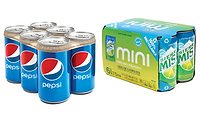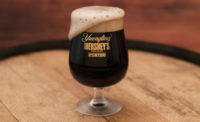![]()
Innovation Abounds in ’04
By Sarah Theodore
The past year featured a
number of new packaging options for beverages, ranging from very functional
to just very attractive. In some cases, brand new technology found its way
to store shelves, and in other cases, existing packaging materials were
used to take products into new venues or to create new marketing
advantages. We’ve highlighted some of the packages that stood out
this year for their innovation and creativity.
Turn on the heat
In the ever-increasing attempt to make packaging more
convenient, On-Tech LLC, San Diego, has introduced the self-heating can to
the U.S. market, and one of the first finished beverage products to use the
technology is WP Beverage Partners’ Wolfgang Puck Gourmet Lattes. To
complement its line of chilled lattes, the company recently debuted the
line in On-Tech cans that heat the product to 140° F in six to eight
minutes.
The package is constructed as a can within a can
— the inner can contains crushed limestone and the outer can contains
the beverage. The package also has a sealed disc containing water that,
when a consumer pushes a button on the bottom of the can, is released into
the limestone, causing a thermal reaction that heats the beverage. The can
has a tamper-proof overcap on the top, and when the product is heated to
the correct temperature, the glue holding the overcap melts, allowing it to
be turned to access the pull-tab.
In addition to the new can, WP Beverage Partners used
thermal ink on the package label that changes color when the product is
heated to the right temperature. Retail pricing for the new lattes runs
between $2.29 and $2.79 for single cans, or $8.99 per four-pack.
The On-Tech can isn’t limited to beverages; it
can be used to package soup and baby formula as well, and the company
recently announced it has partnered with Lakeside Foods, Manitowoc, Wis.,
to process products in the self-heating can at Lakeside’s Belgium,
Wis., plant.
Tracking technology
This summer’s Coca-Cola GPS can ran afoul of the
U.S. military, but we found it to be one of the most innovative packages of
the year. The company merged packaging and promotion with the specialty can
that featured Global Positioning System and cell phone technology. Instead
of cola, the cans contained a cell phone that the winning consumer could
activate to receive a Chevy Equinox SUV, and a GPS system that allowed
Coca-Cola to track winners and deliver the prize right to their doors.
Apparently, the technology was a little too innovative for some military
officials who feared it could be used to eavesdrop. Those attending
classified meetings or top-secret areas reportedly were asked to examine
their soda cans before entering.
The idea for the can originated in Australia, but
evolved from simply placing a cell phone in the can to incorporating the
technology right into the container. “The whole theory behind the
promotion is not the prize itself, but the way we find the winners,”
said Brand Manager, Coca-Cola Trademark Doug Rollins. “We enter
consumers’ lives and bring them unexpected excitement and adventure
like they may have never had before.”
Earth-friendly bottle
Helping keep the environment strong, BIOTA Brands of
America and Naturally Iowa have rolled out products in new corn-based
NatureWorks PLA beverage bottles. The plastic bottles were developed by
Cargill Dow, Minnetonka, Minn., for short-life, cold-fill applications, and
are transparent so consumers can see the product inside. But the real
benefit of the bottles is that they are made from renewable resources and
recently were approved by the Biodegradable Products Institute (BPI).
According to BPI, NatureWorks PLA will biodegrade “swiftly and safely
during municipal or commercial composting.” It is the first bottle
approved by the association.
BIOTA (an acronym for Blame It On The Altitude) Spring
Water is bottled in Ouray, Colo., and is offered in 1-liter, half-liter and
12-ounce “stubby” bottles, all made from NatureWorks PLA.
Naturally Iowa, Clarinda, Iowa, has used the new material for its
half-gallon grip bottle, and is working with Cargill Dow on packaging for
its single-serve beverages.
According to Cargill Dow, monolayer NatureWorks PLA
bottles can be formed on the same injection-molding and stretch
blowmolding equipment used for PET, at the same production rate. And it has
been shown to offer the same organoleptic properties as glass and PET. The
bottles can be recycled through a traditional U.S. recycling stream or
composted in commercial systems, where they degrade in 75 to 80 days.
New in wine
Wine packaging has made great strides during the past
few years, from the ubiquitous 750-ml. glass bottle to any number of sizes
and material options. Fetzer Vineyards this year expanded its package
offerings with the SurShot multi-layer, injection-molded PET bottle. Fetzer
says oxygen barriers in the bottles, which also feature screw caps, allow
the company to keep the wines preservative-free. The company has added the
187-ml. package to its Valley Oaks Merlot, Chardonnay and White Zinfandel
line, and created the package for airlines, resorts and hotels, sports
arenas and other outlets that prohibit glass. The bottles have a shelf life
of close to six months.
Tetra Pak helped Canandaigua change the shape of its
wine business, with the 500-ml. Tetra Prisma
Pak used this spring for Almaden Red Sangria, and more recently, to package
four varieties of Vendange wines. While the Almaden package used a pull tab
opening, the new Vendange Prisma Paks feature StreamCap screw-caps that are
tamper-evident and allow the package to be resealed after opening. The line
includes Cabernet Sauvignon, Chardonnay, Pinot Grigio and Shiraz, and each
variety is color-coded for easy recognition.
MeadWestvaco this year developed a new three-pack wine
carrier for the Colorado Wine Industry Development Board, which wanted a
promotional package that local wineries could use to display and sell
take-home mix-and-match packs of wine. The company’s Forte
solid-fiber board provided the strength needed to hold the wine bottles,
and a smooth printing surface for photographic printing on the
carton’s exterior. It also helps inhibit curl and wave problems
associated with dry climates such as Colorado’s. The wine development
board replaced the fluted packaging it previously used with the new Forte
material, and it hopes the new carriers will promote more trial and repeat
purchases of Colorado wines. Cans take a new shape
Aluminum is expanding from traditional soft drink cans
to tall bottles and creative cans such as Jolt Cola’s new resealable
“Battery Bottle,” created by Rexam Beverage Can Americas. The
23.5-ounce package is the first resealable aluminum container of its size,
according to brand owner Wet Planet Beverages, Rochester, N.Y. In addition
to the new can top, the package incorporates thermo-chromatic ink that
changes color when the beverage is chilled. As the cola is consumed, the
ink returns to its original color, showing the consumer how much liquid is
left in the can.
Cans also were a new package option for trendy Jones
Soda, which like home and runway “fashionistas” Isaac Mizrahi,
Michael Graves and Cynthia Rowley, signed on with Target stores for an
exclusive product offering. This fall, the company rolled out
“interactive” 12-ounce Fridge Packs that feature photos
submitted by consumers. The gourmet soft drink company is known for using a
multitude of bottle labels with photos submitted by amateur and
professional photographers alike. According to the company, it receives
thousands of photos at the Jones Soda Photo Gallery at Jonessoda.com.
The Target Fridge Packs feature seven photos per box,
and will rotate photos over time. Varieties offered
in the Fridge Pack include Green Apple, Blue Bubblegum, Strawberry Lime,
Cream Soda, Root Beer and Sugar-Free Black Cherry.
“We are very excited about the new packaging and
the fact that we are bringing something new to a traditional CSD
category,” said Peter van Stolk, president and chief executive
officer at Jones Soda, about the rollout. “The beverage industry is
competitive, so we at Jones Soda strive to connect with our consumer in a
way that no other company can.”Plastic makes inroads in tea
Honest Tea, Bethesda, Md., took organics to new places
this year with the rollout of new PET packaging for its teas. The company
used new filling technology that eliminated the need for expansion panels
and ribs, creating a smooth, sleek look for the package. Instead of panels,
the bottom of the bottle expands, popping out
during the hot-fill process, and popping back into place when the product
is cooled to shipping temperature. And keeping with Honest Tea’s
sustainable philosophy, the bottles are 100 percent recyclable.
“We wanted to develop an exciting package that complements our glass line while allowing people
to enjoy our tea in new places,” says Seth Goldman, president and
“Tea-EO” at Honest Tea. “And we wanted to do it in a way
that didn’t compromise our brand or our commitment to
sustainability.”
Describing sustainability as “not an end-point,
but a journey,” Goldman says, “We will continue to search for
ways to reduce our impact on the environment while creating delicious,
healthy products.”
The company’s first PET recipient was new
Independence Airline, and the line includes Green Dragon Tea, Lori’s
Lemon Tea, Peach Oo-La Long and Black Forest Berry.
Also offering unique and attractive tea packaging this
year was Revolution Tea, Tempe, Ariz., with new plastic bottles for its
white teas. The shapely bottles are wrapped in white shrinkwrap with
colorful photography of each of the fruits used in the tea blends. The line
contains no sugar or sweeteners and no preservatives, and is available in
Key Lime, Tangerine, Blackberry and Raspberry flavors.Shelf-appeal
Cadbury Schweppes Americas Beverages introduced Rose’s Cocktail Infusions this summer
in a set of three curvy glass bottles that fit together to create a display
piece. Rose’s is best known for lime juice and grenadine, but
Infusions are flavored martini mixers intended to streamline the
cocktail-making process. Aimed at female consumers, the mixers can be used
to create Appletinis (Sour Apple Mix), Cosmopolitans (Cranberry Twist Mix),
and Raspberry martinis (Blue Raspberry Mix), or any number of other drinks
that can be created with the three flavors. While the bottles retail
individually, they’re at their best when placed together to show off
their wavy design. BI



